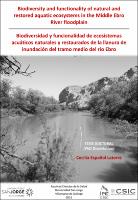Por favor, use este identificador para citar o enlazar este ítem:
https://repositorio.usj.es/handle/123456789/119
| Título : | Biodiversidad y funcionalidad de ecosistemas acuáticos naturales y restaurados de la llanura de inundación del tramo medio del río Ebro = Biodiversity and functionality of natural and restored aquatic ecosystems in the middle Ebro river floodplain |
| Autor: | Español Latorre, Cecilia Inmaculada

|
| Afiliación : | Universidad San Jorge Consejo Superior de Investigaciones Científicas. Instituto Pirenaico de Ecología |
| Palabras clave : | Limnología |
| Fecha de publicación: | 2015 |
| Citación : | ESPAÑOL LATORRE, CECILIA I. Biodiversidad y funcionalidad de ecosistemas acuáticos naturales y restaurados de la llanura de inundación del tramo medio del Río Ebro = Biodiversity and functionality of natural and restored aquatic ecosystems in the middle Ebro river floodplan. [S.l.]: [s.n.], [s.a.] |
| Resumen : | Floodplains are one of the ecosystems that provide greater value of services and goods per surface unit to society, such as flood protection, water purification, diversity of habitats, carbon sequestration, and cultural and recreational services. Despite their importance, floodplains are under severe anthropic pressure mainly due to flow regulation and agricultural intensification. These pressures are expected to increase worldwide in the next decades, with Mediterranean regions as one of the most vulnerable areas. It is for this reason that restoration has become one of the most important management tools for the conservation of river-floodplains. Generally, the main aims of floodplain restoration are to improve water quality and increase floodplain biodiversity. However, little is known about the recovery of ecosystem properties and functionality. Furthermore, restoration projects mostly focus on the assessment and monitoring of surface ecosystems, whereas groundwater ecosystems remain vastly unknown. To close this knowledge gap, the general objective of this PhD dissertation is to evaluate the effects of ecological restoration measures upon the biodiversity and functionality of aquatic surface and groundwater ecosystems. We hypothesized that ecosystem restoration in a degraded floodplain improves water quality and increases habitat diversity and, consequently, provides novel and heterogeneous resources and refuges for species and biogeochemical processes. Specifically, we focus on evaluating the effects of two ecological restoration measures: i) the construction of wetlands; and ii) the expansion of riparian forest uses against agricultural uses in the floodplain. To that end, we selected the Middle Ebro River-floodplain (NW, Spain) as main study area. Using restored ecosystems (i.e. constructed wetlands and riparian forest uses) and non-restored ecosystems (i.e. degraded natural wetlands and agricultural uses), we have evaluated the following structural and functional aspects: i) water physicochemical characteristics in wetlands and the alluvial aquifer; ii) species and functions composition of macroinvertebrate communities in wetlands and the alluvial aquifer; iii) taxonomic and functional diversity indices of macroinvertebrate communities in wetlands and the alluvial aquifer; iv) net ecosystem production in wetlands; and v) methane emissions in wetlands. Results obtained in the current PhD dissertation demonstrate the effectivity, at least in the short-to-medium term, of ecological restoration to improve the structure and functionality of degraded floodplains. The 61% of the studied structural indicators and 89% of the functional indicators recovered and even improved after floodplain restoration. This fact was associated to lower water eutrophication and turbidity, and higher substratum and vegetation diversity of the restored in comparison to non-restored ecosystems. Specifically, constructed wetlands showed significantly higher abundance and richness of macroinvertebrates than degraded natural wetlands. Besides, the macroinverterbate community showed more diversity of functional traits related to reproduction, dispersion and feeding habits in constructed wetlands than in degraded natural wetlands. The rapid recovery in aquatic communities contrasts with the poor rates of net ecosystem production in constructed wetlands in comparison to those recorded in degraded natural wetlands, seven times lower. Differences between wetlands were more evident at the pelagic level, observation mainly associated to the low nutrient content and organic matter accumulation of constructed wetlands. Conditions that in turn, are one of the main reasons of the lower methane emission rates in constructed wetlands in comparison to the emissions of degraded natural wetlands, registering values four times lower. As for the groundwater ecosystem, floodplain areas occupied by riparian forest showed higher abundance, taxonomic diversity and functional diversity in their alluvial aquifer than areas occupied by agricultural uses. Additionally, biogeochemical filtration and particulate organic matter breakdown capacities also increased under natural forest land. In conclusion, outcomes of the current PhD dissertation demonstrate the suitability of ecological restoration as a management strategy for the conservation and improvement of the biodiversity and functionality of floodplains of large regulated Mediterranean rivers. Moreover, we highlight the importance of considering both structural and functional aspects in all steps of a floodplain restoration project to optimize its long-term effectiveness, so as to provide and support key species and functions in the ecosystem and, consequently, maximize the ecosystems services provided by floodplains. |
| URI : | https://repositorio.usj.es/handle/123456789/119 |
| Aparece en las colecciones: | Facultad de Ciencias de la Salud |
Ficheros en este ítem:
| Fichero | Descripción | Tamaño | Formato | |
|---|---|---|---|---|
| Cecilia Español Biodiversidad y funcionalidad de ecosistemas.pdf | 14 MB | Adobe PDF |  Visualizar/Abrir |
Este ítem está sujeto a una licencia Creative Commons Licencia Creative Commons

